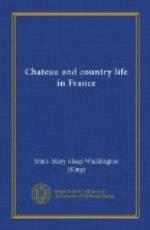The road all the way to Villers-Cotterets was most animated. It was market-day, and we met every description of vehicle, from the high, old-fashioned tilbury of the well-to-do farmer, to the peasant’s cart—sometimes an old woman driving, well wrapped up, her turban on her head, but a knit shawl wound around it, carrying a lot of cheeses to market; sometimes a man with a cow tied behind his cart, and a calf inside. We also crossed Menier’s equipage de chasse, horses and dogs being exercised. We talked a few minutes to Hubert, the piqueur, who was in a very bad humor. They had not hunted for some days, and dogs and horses were unruly. The horses were a fine lot, almost all white or light gray. We go sometimes to the meets, and the effect is very good, as the men all wear scarlet coats and the contrast is striking.
We had an exhausting day in Paris, but managed to get pretty nearly everything. The little children were easily disposed of—dolls, drums, wooden horses, etc.; but the bigger boys and girls, who have outgrown toys, are more difficult to suit. However, with knives, paint-boxes, lotos (geographical and historical), for the boys; and handkerchief and work-boxes, morocco bags, etc., we did finally get our fifty objects. There are always extra children cropping up. Shopping was not very easy, as the streets and boulevards were crowded and slippery. We had a fairly good cab, but the time seemed endless. The big bazaars—Hotel de Ville, rue d’Amsterdam, etc.—were the most amusing; really, one could get anything from a five-sou doll to a menagere (the little cooking-stove all the peasant women use in their cottages). There were armies of extras—white-aproned youths, who did their best for us. We explained to one of the superintendents what we wanted, and he gave us a very intelligent boy, who followed us about with an enormous basket, into which everything was put. When we finally became almost distracted with the confusion and the crowd and our list, we asked the boy what he had liked when he was eleven years old at school; and he assured us all boys liked knives and guns.




